NavSource Online: Submarine Photo Archive
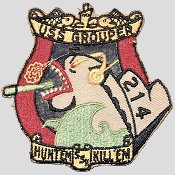
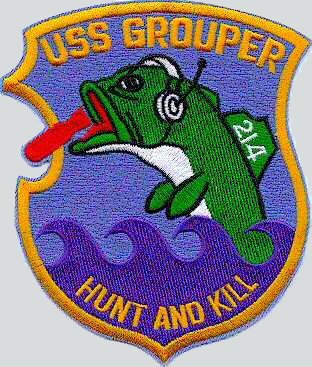
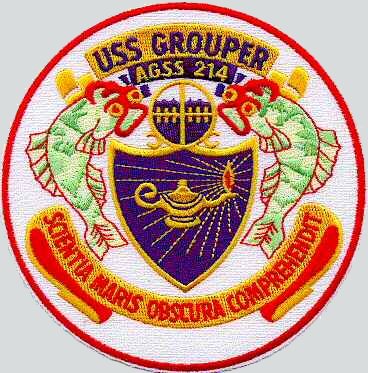
Patches contributed by Mike Smolinski
Please report any broken links or trouble you might come across to the Webmaster.
Please take a moment to let us know so that we can correct any problems and make your visit as enjoyable and as informative as possible.



| Click On Image For Full Size | Size | Image Description | Source | |
|---|---|---|---|---|
 | 34k | Commemorative postal cover marking the Grouper's (SS-214) keel laying, 28 December 1940, at the Electric Boat Co., Groton, CT. | Courtesy of petloveshack.com. | |
 | 174k | Commemorative postal cover marking the Grouper's (SS-214) keel laying, 28 December 1940, at the Electric Boat Co., Groton, CT. | Photo courtesy of Scott Koen & ussnewyork.com. | |
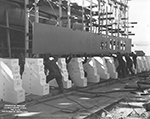 |
277k | Growler's (SS-215) keel being laid down, 10 AM on 10 February 1941, at the Electric Boat Co., Groton, CT. Note the Grouper (SS-214) being built above and to the left. |
Electric Boat photo # BS 31122 via NARA College Park, courtesy of Tracy White @ Researcher @ Large. | |
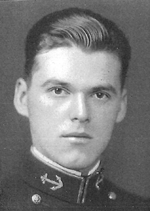 0821435 |
NR | Like a lot of vessels, the Grouper (SS-214) was sponsored by the wife of a naval figure; Mrs. Albert T. Church. Her husband Admiral Albert T. Church was awarded the Legion Of Merit Award His citation reads: "For exceptionally meritorious conduct in the performance of outstanding services to the Government of the United States as Director of the United States Naval Engineering Experiment Station from 19 October 1939, to 19 September 1944. Entering upon this important duty at a time of urgent need for tremendously increased facilities vital to the success of the shipbuilding program, Rear Admiral Church achieved the expansion project without interruption of work at hand and, in adBition, provided capacity for greater increase. A thorough and vigorous administrator, extraordinary skillful in directing t.he research, development and testing activities of the Engineering Experiment Station during a critical period, Rear Admiral Church has contributed distinctively to the expeditious expansion and the successful operation and maintenance of the largest Navy in the world." The Admiral & his wife Marion have brought 3 generations of Admirals with this name into the US Navy ranks. Their son Admiral Albert T. Church II is pictured above. |
Text provided by calhoun.nps.edu Photo of Admiral Albert T. Church II via history.navy.mil |
|
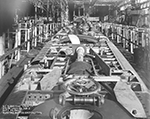 |
409k | Growler (SS-215), looking forward, 30 September 1941. The Grouper (SS-214) is under construction to the right of the photo and the Grunion (SS-216) is to the left. |
Photo i.d. courtesy of Robert Morgan. Electric Boat photo # BS 31127 via NARA College Park, courtesy of Tracy White @ Researcher @ Large. |
|
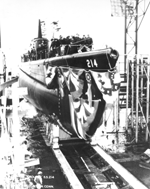 | 291k | Grouper (SS-214), sliding down the launching ways at the Electric Boat Co., Groton, CT., 27 October 1941. | USN photo courtesy of ussubvetsofworldwarii.org. | |
 | 31k | Commemorative postal cover marking the Grouper's (SS-214) launching on 27 October 1941. | Courtesy of Jack Treutle (of blessed memory). | |
 | 30k | Commemorative postal cover marking the Grouper's (SS-214) launching, 27 October 1941. | Courtesy of petloveshack.com. | |
 | 44k | The Grouper (SS-214) sometime during her sea trials, 27 October 1941 & her commissioning, 12 February 1942. | Courtesy of petloveshack.com. | |
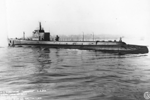 | 729k | Grouper (SS-214) at rest on 24 January 1942. | USN photo courtesy of Scott Koen & ussnewyork.com. | |
 | 420k | Restless Grouper (SS-214) on 24 January 1942. | USN photo courtesy of Scott Koen & ussnewyork.com. | |
 | 19k | Commemorative postal cover marking the Grouper's (SS-214) commissioning on 12 February 1942. | Courtesy of Jack Treutle (of blessed memory). | |
 |
271k | On her second patrol (28 August-9 October) Grouper (SS-214) had the satisfaction of sending to the bottom two freighters, Tone Maru on 21 September and Lisbon Maru on 1 October. When Lisbon Maru was sunk by Grouper on 1 October 1942, she was carrying, in addition to Japanese Army personnel, 1,816 British and Canadian prisoners of war captured after the fall of Hong Kong in December 1941. The British government insisted that over 800 of these men died either directly as a result of the sinking, or were shot or otherwise killed by the Japanese while swimming away from the wreck. The ship was not marked to alert Allied forces to the nature of its passengers. However, over 1,000 Allied prisoners were rescued by the Japanese military. The Japanese Government insisted that British prisoners were in fact not deliberately killed by Japanese soldiers and chastised the British Government. |
Photo courtesy of Tommy Trampp. Text courtesy of DANFS & en.wikipedia.org | |
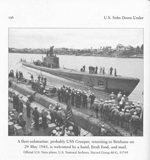 |
452k | Photo caption reads: A fleet submarine, probably Grouper (SS-214), returning to Brisbane on 29 May 1943, is welcomed by a band, fresh food and mail. A little more indirect evidence about Boat #1 being Grouper is in her patrol report endorsements. In a letter dated 31 May 1943, there is a reference to the just arrived Grouper having her bridge cut down in that refit. If the 4-7 June date is correct, then it would mean that Boat #1/Grouper was photographed in mid cut down. It looks like Fulton (AS-11) got to Grouper just a day or two before Albacore (SS-218). She still has the high bridge forward and shows the starboard small boat locker bulge. It looks like they cut down the after cigarette deck and the shears, but not the forward bridge so they were clearly doing this in little stages. The boat she's approaching is probably Albacore based upon the drilled casing roundover. Guardfish (SS-217) departed on the 25th, so Albacore is the likely suspect. |
Photo i.d. & text courtesy of Robert Morgan. Photo courtesy of Robert Morgan courtesy of US Subs Down Under, 1942-1945 by David Jones & Peter Nunan. |
|
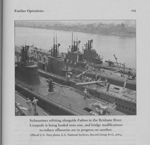 |
640k | Photo caption reads: Submarines refitting alongside Fulton (AS-11) in the Brisbane River. A torpedo is being loaded onto one, and bridge modifications to reduce silhouette are in progress on another. Boat #1: Grouper (SS-214), Boat #2: Peto (SS-265), Boat #3: Scamp (SS-277), Boat #4: Albacore (SS-218), Boat #5: Drum (SS-228), 4-7 June, 1943. EB plan 2053-29, and BuShips plan 388778. Its a general outboard arrangement for SS-214-221 and SS-253-254. It shows very plainly that boats from SS-214 onwards only had the one small boat locker. Grouper only had the one small boat locker offset to port, but she carried the bulge to starboard as if she had one there too, only she didn't! The plan very clearly shows the bulge to starboard for Grouper, but then states, "DECKLINE FOR SS-214 ONLY." Grouper being modified with her bridge being cut down after her May 29 return from patrol with a high fairwater as in the US Subs Down Under photo, which would explain the whitish look to her bridge face; it was probably primer or wet paint. The bulge to starboard that I originally thought indicated either Gato (SS-212) or Greenling (SS-213) is there, but there just isn't any locker beneath it! Why EB built Grouper like this is anyone's guess. Perhaps when the change order came, construction on Grouper was already too far ahead to stop and re-contour the deck casing? EB wasn't known for deviating from the plans lightly, so perhaps this was the best the Navy could get out of them? They then went to the single locker and no starboard bulge of any kind starting with Growler (SS-215). This might explain why the Manitowoc boats had the single locker, too, since their contract was to build copies of Growler herself, portholes in the bridge face notwithstanding. EB initially resisted pressure from the Navy to alter the plans, citing concerns about delays in production if they did. What they were really worried about was making a profit, each little change cost more and ate into their profit margin. This attitude was somewhat understandable, as EB is a civilian company and they existed to make a profit for their shareholders. However, EB's intransigence got so bad that the Bureau of Ships had to threaten the company with making them build the boats to the Government plans supplied by Portsmouth, wiping out their design capability, which would have put them in a very bad spot commercially after the war. EB backed off when they realized how serious the Bureau was. They took on a whole new attitude and their resistance to change quickly evaporated. What you are seeing with Grouper is an outgrowth of this situation. As part of an attempt to eliminate what the Bureau thought was "frivolous" peacetime equipment on the boats, an order was issued on 10 May 1942 to eliminate the motorboat. This was the official order that legitimized a practice that was already going on in the fleet. Many of the submarines beached the motorboat(s) between patrols as it became clear that they were just not needed anymore. Grouper was probably built with the original capacity of having two boats, as was the original intent for the Gato class. But she may have only gotten one boat when she was finished. Albacore's patrol report backs up her being Boat #4. It reads, in part, "Major items accomplished during refit - alteration of bridge superstructure for mounting additional 20 mm gun." This was for her refit between 27 May and 10 June, 1943, so the dates connect up nicely with the photo. Either way, the dates look solid, and the activity in the photo looks like a June, 1943, photo. Peto would depart on patrol on June 13th, so the boxes on her foredeck are probably supplies being loaded up. |
Photo i.d. & text courtesy of Robert Morgan & David Johnston. Photo courtesy of Robert Morgan courtesy of US Subs Down Under, 1942-1945 by David Jones & Peter Nunan. |
|
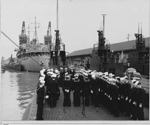 | 1.40k | Citation from Admiral Carpender aboard the Guardfish receiving their submarine combat insignia on 18 August 1943. The boats in the background are: Peto (SS-265) in the middle. Interesting that she still has the high bridge forward. She would depart on 9/1/43, so unless the tender did a quick cut down, she would have departed on patrol in September still with a high bridge. Even if they did cut it down before she departed, its interesting that she still had it as late as August. I had no idea they were splotching the periscopes that early, a great detail for modelers. Scamp (SS-277) to the right. Assuming the August 18 date is correct, that would match up. Scamp departed on patrol on September 2nd, so she would have been there. If the boat to her port is a high bridged type (hard to tell, but from the sailor peeking out of the dead light, maybe), then she would be Peto, who was likely the only high bridge type there, and probably the very last one. She would depart on September 2nd. Others in port at that time included Albacore (SS-218), Stingray (SS-186), Grouper (SS-214) and likely Gato (SS-212). All departed Brisbane between August 23rd and September 6th. Grouper is to the left in the background moored with the Fulton (AS-11). The boat to her starboard whose extreme stern is probably Tuna (SS-203). She had left for patrol before the awards ceremony date, but a friendly fire incident with an RAAF bird forced her back into Brisbane for repairs, so she had reentered port and didn't leave again until August 21st, 1943. She had the aft torpedo tube shutters as-built like the other Tambors, and like the mystery boat. It's hard to see and faint but the mystery boat appears to have the degaussing circuit on her stern. | Majority text i.d. courtesy of Robert Morgan, with input from David Johnston (USN, retired) & John Hummel, USN (Retired). US National Archives photo # 80-G-394390 & 80-G-394401 from National Archives and Records Administration (NARA), College Park, Maryland, courtesy of Sean Hert. |
|
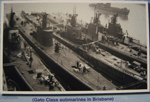 |
391k | The boats shown are all Gato's. Boat #1: Grouper (SS-214), Boat #2: Peto (SS-265), Boat #3: Scamp (SS-277), Boat #4: Albacore (SS-218), Boat #5: Drum (SS-228), 4-7 June, 1943. |
Photo i.d. & text courtesy of David Johnston. Photo courtesy of Gerhard Mueller-Debus via Gary Priolo. |
|
 | 91k | At the conclusion of her eighth patrol Grouper (SS-214) headed for the States and overhaul, reaching San Francisco 19 October 1943. She is seen here broadside on 22 December 1943. | USN photo courtesy of Ed Zajkowski. | |
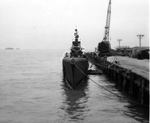 0821425a | 1.21k | Bow on view of the Grouper (SS-214), 27 December 1943. | USN photo courtesy of Ed Zajkowski. | |
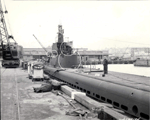 | 288k | Last days of the Grouper (SS-214) at Mare Island, 27 December 1943. She returned to Pearl Harbor on 7 January 1944. | US Navy / B.S. photo # 57194, courtesy of Ed Zajkowski. | |
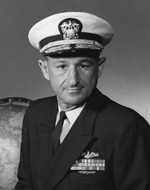 0822812 |
786k | The Grouper (SS-214) was commanded by Maurice H. Rindskopf from 05.1945 to 09.05.1945. | Official US Navy photo of RADM Maurice H. Rindskopf, dated 16 July 1967, from the files of the Vallejo Naval & Historical Museum courtesy of Darryl L. Baker & Wolfgang Hechler. | |
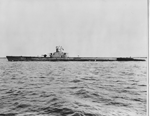 | 580k | Grouper (SS-214), in 17 July 1945, off Mare Island wearing Ms 32/3SS-B camoflage scheme. The photo shows 40-mm guns fore & aft, a new 3 in/25 gun forward, and a twin 20-mm mount aft in a space into which a second 3 in/25 gun could fit (submarines normally carried one gun in either location). | Partial text courtesy of U.S. Submarines Through 1945, An Illustrated Design History by Norman Friedman. Naval Institute Press. US National Archives photo # 80-G-1041909, from National Archives and Records Administration (NARA), College Park, Maryland, courtesy of Sean Hert. |
|
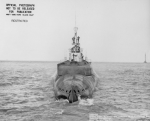 | 186k | Stern view of Grouper (SS-214), departing Mare Island on 17 July 1945. | USN photo # 5299-45, courtesy of Darryl L. Baker. | |
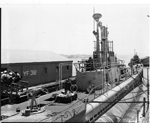 | 404k | Plan view Grouper (SS-214) at Mare Island on 17 July 1945. The barge YF-312 is in the background. | USN photo # 5335-45, courtesy of Ed Zajkowski. | |
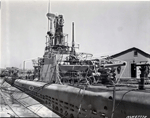 | 404k | Plan view amidships looking aft, 17 July 1945. | USN photo # 5336-45, courtesy of Ed Zajkowski. | |
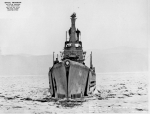 | 211k | Bow on view of Grouper (SS-214), off Mare Island on 17 July 1945. | USN photo # 5303-45, courtesy of Darryl L. Baker. | |
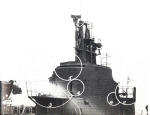 | 78k | This close up of the Grouper (SS-214),shows the standard arrangement of the "SJ" radar. The radar was mounted forward of the periscopes. The "SD" radar is visible aft of the other lookout platform above the searchlight. The forward torpedo loading hatch is open, ready to load "fish". Note the newly added 20mm gun pedestal base. | USN Archives Photo # 19-N-87825, courtesy of The Floating Drydock, Fleet Subs of WW II, by Thomas F. Walkowiak. | |
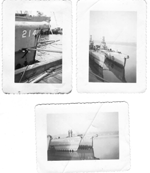 | 181k | Group of Grouper (SS-214) photos with a torn hull, unknown cause, circa 1946-50, probably at New London, CT. She is seen here with the Finback (SS-230). | Photo courtesy of Daniel E. Whaley, Jr. of blessed memory via his daughter, Carol Poole. | |
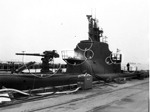 | 240k | Grouper (SS-214) typifies the Gato-class (SS-212-84) at the end of WW II. This photo was taken on 15 May 1950 when the submarine was being prepared for conversion for ASW. By this time all the guns had been landed. The new SS radar had replaced the earlier SJ; the big antenna was for the wartime SV air search set. Note the venturi at the fore end of the bridge. By this time the DF loop for underwater HF reception was generally mounted between the two periscopes. | Text courtesy of U.S. Submarines Through 1945, An Illustrated Design History by Norman Friedman. Naval Institute Press. Photo courtesy of Ed Zajkowski. |
|
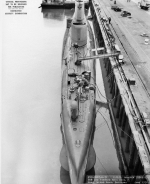 | 196k | Forward plan view of Grouper (SS-214) at Mare Island in late June 1951. Shipyard records indicate she was converted from 15 May 1950 to 29 June 1951. | USN photo # 9667-6-51, courtesy of Darryl L. Baker. | |
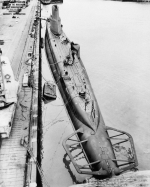 | 197k | Aft plan view of Grouper (SS-214) at Mare Island in late June 1951. | USN photo # 9669-6-51, courtesy of Darryl L. Baker. | |
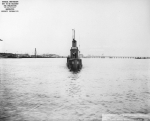 | 213k | Bow on view of Grouper (SS-214) departing Mare Island in late June 1951. | USN photo # 9748-6-51, courtesy of Darryl L. Baker. | |
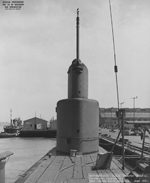 |
93k | Fairwater, looking aft, June 1951. | Mare Island Navy Yard Ship Files, NARA San Francisco, Photo # NY9-9665-6-51, courtesy of Tracy White @ Researcher @ Large. | |
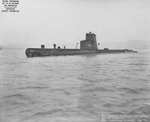 |
145k | Port side view, June 1951. | Mare Island Navy Yard Ship Files, NARA San Francisco, Photo # NY9-9749-6-51, courtesy of Tracy White @ Researcher @ Large. | |
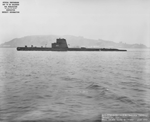 |
154k | Broadside view of the Grouper (SS-214), June 1951. | Mare Island Navy Yard Ship Files, NARA San Francisco, Photo # NY9-9750-6-51, courtesy of Tracy White @ Researcher @ Large. | |
 | 305k | Secretary of the Navy D. A. Kimball (Stetson over heart during ceremony) and party during a photo op held dockside prior to their boarding the Flying Fish (SS-229). The Sea Robin (SS-407) & Grouper (SS-214) are in the background. |
Photographer:Peter Stackpole, courtesy of time.com. via Bill Gonyo & Life. | |
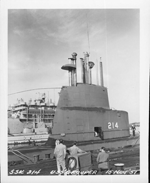 | 212k | Grouper (SS-214) dockside on 15 November 1951. | USN photo courtesy of Darryl L. Baker. | |
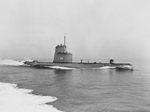 | 1.22k | Grouper (SSK-214) appears here on 18 April 1952. With the addition of a snorkel and extensive sonar and radar facilities Grouper emerged from the Mare Island yard 27 June 1951 to pioneer in research on the deadly submarine-versus-submarine warfare. For the next 8 years, as a unit of Submarine Development Group 2, Grouper worked to develop and test concepts of hunter-killer antisubmarine warfare. In this duty she ranged along the East Coast from Nova Scotia to Florida as well as participating in Caribbean exercises. In 1953 and 1955 exercises took Grouper across the Atlantic to Rothesay, Scotland, via Iceland. | Text courtesy of DANFS. Photo # USN 442268 scanned by Ryan Crierie, via flickr, courtesy of Stephen Gower. | |
 | 299k | Nothing like going on a vacation to Bermuda. The Blenny (SS-324), Grouper (SS-214) & Cavalla (SS-244) appear here sometime after 1953. | Photo courtesy of John Hummell. | |
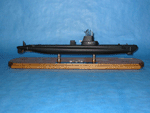 | 115k | Broadside & starboard quarter view of the Grouper (SS-214) in 1/192 scale, solid cast resin. | Model & photo courtesy of Mel Douyette & coldwarsubmarines.com | |
 | 183k | Grouper (SS-214) undergoing post overhaul sea trials off Portsmouth, NH, May 1960. Grouper shared the yard with new-construction Abraham Lincoln (SSBN-602), Thresher (SSN-593) and with Nautilus (SSN-571) (first refueling) and often had to fight for attention. But Portsmouth's work made Grouper distinctive. PUFFS passive ranging hydrophones (ten-footers) are in the three large fins. The billboard-like housing for the "planar array" made for stability concerns - Grouper always rolled to port on surfacing. During surface transits strict rig-for-dive was broken to run with the LP blower lined up to blow port side only, because of the list she sometimes developed in weather. Aft of the sail is the Colossus active sonar. It was powered by a large MG set in (converted) #7 MBT. Not visible: Linear array of line hydrophones which ran the length of the starboard side. Prairie and Masker air piping (extra large blower in pump room). All six forward torpedo tubes removed. | Photo & text submitted by former crew member Tom Keaveny. | |
 | 20k | Commemorative postal cover marking the 20th anniversary of the Grouper (SS-214), 2 February 1942-62. | Courtesy of Jack Treutle (of blessed memory). | |
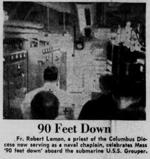 0821461 |
427k | 90 Feet Down Fr. Robert Lemon, a priest of the Columbus Diocese now serving as a naval chaplain, celebrates Mass '90 feet down' aboard the submarine Grouper (SS-214). |
Image and text provided by Ohio History Connection, Columbus, OH. Photo from The Catholic Times. [volume] (Columbus, Ohio) 1951-current, 17 February 1961, Image 1, via chroniclingamerica.loc.gov. |
|
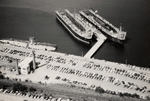 | 2.08k | Subase Groton, CT.: The photo shows Grouper (AGSS-214) alongside an unidentified Government design Balao/Tench, with a Permit class boat in the drydock. I would guess the date to be approximately 1968. It looks like Grouper is going through the decommissioning process so that give us a rough date. | Photo & text i.d. courtesy of David Johnston. USN photo # NPC K-85366 courtesy of Scott Koen & ussnewyork.com | |
| Back To The Main Photo Index | Back To the Submarine Index |
| Problems and site related matters, E-mail Webmaster |
| This page is created by Gary Priolo, and maintained by Michael Mohl All Pages © 1996 - 2024 NavSource History All rights reserved. |